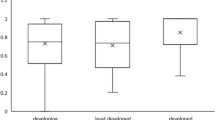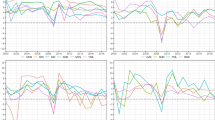Abstract
This paper investigates and compares the effect of financial liberalization on economic activity of developed and emerging economies, and explores the channels of capital accumulation and total factor productivity improvements through which economic activity can be enhanced. The theoretical and empirical literature has been marred with inconclusiveness because of, inter alia, clubbing different country groups together; addressing equity liberalization inadequately; leaving banking liberalization unaddressed; scantily covering the channels of economic activity; and measuring financial liberalization inadequately. Against this background, our sample consists of nine major developed and nine major emerging economies over a period of 1971–2013. We used panel data modeling technique and estimated a two-step GMM model to overcome the issue of endogeneity. We find financial liberalization to enhance economic activity in both set of countries; capital accumulation in the emerging economies; and TFP improvements in developed economies. Banking liberalization effect in emerging economies albeit is insignificant.
Similar content being viewed by others
Notes
Zhen (2012) indicates that policy choices in the neighboring countries impact the policy decisions of a country through multiple mechanisms such as increased difficulty in attracting foreign flows for a given country if it chooses not to liberalize when its neighbor does.
Murphy and Siedschlag (2011) show that value added and employment in ICT-intensive industries grew relatively faster in countries with a higher ex ante human capital stock.
Hanushek and Kimko (2000), made an important distinction between the quantity and quality of education.
References
Anderson, T. W. (1984). An introduction to multivariate statistical analysis. New York: Wiley.
Arellano, M. (1987). Computing robust standard errors for within-groups estimators. Oxford Bulletin of Economics and Statistics, 49(4), 431–434.
Arteta, C., Eichengreen, B., and Wyplosz, C. (2001). When does capital account liberalization help more than it hurts?, NBER Working Paper No. 8414.
Atiken, B. J., & Harrison, A. E. (1999). Do domestic firms benefit from direct foreign investment? Evidence from Venezuela. The American Economic Review, 89(3), 605–618.
Baltagi, B. H. (2001). Test of hypotheses with panel data. econometric analysis of panel data (2nd ed., pp. 53–75). England: Wiley.
Bartolini, L., & Drazen, A. (1997). Capital-account liberalization as a signal. The American Economic Review, 87(1), 138–154.
Basu, A., and Srinivasan, K. (2002). Foreign direct Investment in Africa—some case studies, IMF Working Paper WP/02/61.
Bekaert, G., & Harvey, C. R. (2000). Foreign speculators and emerging equity markets. Journal of Finance, 55(2), 565–613.
Bekaert, G., Harvey, C. R., & Lundbald, C. (2005). Does financial liberalization spur growth? Journal of Financial Economics, 77, 3–55.
Bekaert, G., Harvey, C. R., & Lundbald, C. (2011). Financial openness and productivity. World Development, 39(1), 1–19.
Bekaert, G., Harvey, C. R., & Lundblad, C. (2003). Equity market liberalization in emerging markets. The Federal Reserve Bank of St. Louis Review, 85(4), 53–74.
Bencivenga, V. R., & Smith, B. D. (1991). Financial intermediation and endogenous growth. The Review of Economic Studies, 58(2), 195–209.
Blundell, R., & Bond, S. (1998). Initial conditions and moment restrictions in dynamic panel data models. Journal of Econometrics, 87, 115–143.
Bonfiglioli, A. (2008). Financial integration, productivity and capital accumulation. Journal of International Economics, 76(2), 337–355.
Bonfiglioli, A., and Mendicino, C. (2004). Financial Liberalization, Bank Crisis and Growth: Assessing the Links, SSE/EFI Working Paper Series in Economics and Finance No. 567.
Boot, A. (2000). Relationship banking: What do we know? Journal of Financial Intermediation, 9(1), 7–25.
Borensztein, D. G., & Lee, J. W. (1998). How does foreign direct investment affect economic growth? Journal of International Economics, 45, 115–135.
Brecher, R., & Calos, D. A. (1977). Tariffs, foreign capital and immiserizing growth. Journal of International Economics, 7, 317–322.
Breusch, T. S., & Pagan, A. R. (1980). The lagrange multiplier test and its applications to the model specification in econometrics. The Review of Economic Studies, 47(1), 239–253.
Bumann, S., Hermes, N., & Lensink, R. (2002). Financial liberalisation and economic growth: a meta-analysis. Technical report. London: EPPI-Centre.
Chinn, M. D., & Ito, H. (2002). Capital account liberalization, institutions and financial development: Cross-country evidence. NBER Working Paper No. 8967.
Chinn, M.D., & Ito, H. (2013). The Chinn-Ito Index, Retrieved from: http://web.pdx.edu/~ito/Chinn-Ito_website.htm. Accessed 5 July 2015.
Demirguc-Kunt,A., and Detragiache, E. (1998). Financial Liberalization and Financial Fragility, World Bank Policy Research, Paper No. 1917
Diamond, D. W., & Dybving, P. H. (1983). Bank runs, deposit insurance, and liquidity. The Journal of Political Economy, 91(3), 401–419.
Domer, E. D. (1946). Capital expansion, rate of growth, and employment. Econometrica, 14, 137–147.
Edison, H. J., Levine, R., Ricci, L., & Slok, T. (2002). International financial integration and economic growth. Journal of International Money and Finance, 21, 749–776.
Edwards, S. (2001). Capital mobility and economic performance: Are emerging economies different?, NBER Woking Paper, No. 8076.
Gourinchas, P.O., and Jeanne, O. (2006). The elusive gains from international financial integration, IMF Working Paper WP/04/74.
Grilli, V., & Milesi-Ferretti, G. M. (1995). Economic effects and structural determinants of capital control. IMF Staff Papers, 42(3), 517–551.
Grossman, G.M., and Helpman.E. (1991). Trade, knowledge, spill-over, and growth, NBER Working Paper, No. 3485.
Hansen, L. P. (1982). Large sample properties of generalized moments estimators. Econometrica, 50(4), 1029–1054.
Hanushek, E.A., and Kimko, D.D.(2000). “Schooling, Labor-Force Quality and the Growth of Nations”, American Economic Review, Vol. 90, No.5, pp.1184-1208.
Haskel, J. E., Pereira, S. C., & Slaughter, J. (2007). Does inward foreign direct investment boost the productivity of domestic firms? The Review of Economics and Statistics, 89(3), 482–496.
Hausman, J. A. (1978). Specification tests in econometrics. Econometrica, 46(6), 1251–1271.
Heckscher, E. (1919). The effects of foreign trade on the distribution of income. Ekonomisk Tidskrift, 21, 497–512.
Hellmann, T. F., & Murdock, K. C. (1997). Financial sector development policy: The importance of reputational capital and governance. In R. Sabot & I. Skekely (Eds.), Development strategy and management of the market economy (2nd ed., pp. 269–323). Oxford: Clarendon.
Hellmann, T. F., Murdock, K. C., & Stiglitz, J. E. (1996). Deposit mobilization through financial restraint. In N. Hermes & R. Lensink (Eds.), Financial development and economic growth: theory and experiences from developing economies (pp. 219–246). London: Routledge.
Hellmann, T. F., Murdock, K. C., & Stiglitz, J. E. (2000). Liberalization, moral hazard in banking, and prudential regulation: are capital requirements enough? The American Economic Review, 90(1), 147–165.
Henry, P. B. (2000). Stock market liberalization, economic reform and emerging market equity prices. The Journal of Finance, 55(2), 529–564.
Henry, P. B. (2007). Capital account liberalization: Theory, evidence and speculation. Journal of Economic Literature, 45, 887–935.
Heshmati, A., and Rashidghalam, M. (2016). Estimation of technical change and TFP growth based on observable technology shifters, IZA Institute of Labor Economics, Discussion Paper No. 10448.
Hsiao, C. (2003). Simple regression with variable intercepts. In A. Chesher & M. O. Jackson (Eds.), Analysis of panel data (2nd ed., pp. 27–60). New York: Cambridge University Press.
Isaksson, A. (2006). Total factor productivity, technological change and change in technical efficiency: A global picture. Vienna: Mimeo.
Isaksson, A. (2007). Determinants of total factor productivity: A literature review, Research and Statistics Branch Staff Working Papers, United Nations Industrial Development Organization.
Javorcik, B. S. (2004). Does foreign direct investment increase the productivity of domestic firms? In search of spill-over through backward linkages. The American Economic Review, 94(3), 605–627.
Johnston, R. B., & Sundararajan, V. (Eds.). (1999). Sequencing financial sector reforms: country experiences and issues. IMF: Washington DC.
Kaminsky, G.L., and Schmukler, S.L. (2003). Short-run pain, long-run gain: the effects of financial liberalization, IMF Working Paper, WP/03/34.
Klein, M., and Olivei, G. (2005). Capital account liberalization, financial liberalization, financial depth and economic growth, NBER Working Paper Series, 7384.
Kose, M.A., Prasad, E.S., and Terrones, M.E. (2007). How does globalization affect risk sharing? Patterns and channels, IMF Working Paper, WP/07/238.
Kose, M.A., Prasad, E.S., and Terrones, M.E. (2008). Does openness to international financial flows raise productivity growth, NBER Working Paper, No. 14558.
Kraay, A. (1998). In search of the macroeconomic effects of capital account liberalization. Washington: The World Bank.
Krugman, P. (1979). Increasing returns, monopolistic competition, and international trade. Journal of International Economics, 9(4), 469–479.
Krugman, P. (1993). Challenging conventional wisdom. Reprinted in: Krugman P (1996) Pop Internationalism. MIT Press, Cambridge Mass, pp. 129–154.
Lane, P., & Milesi-Ferretti, G. M. (1999). The external wealth of nations: Measures of foreign assets and liabilities for industrial and developing nations. IMF Working Paper, WP/99/115.
Lane, P., Milesi-Ferretti, G.M. (2006). The external wealth of nations Mark II, IMF Working Paper, WP/06/69.
Levine, R. (2001). International financial liberalization and economic growth. Review of International Economics, 9(4), 688–702.
Mckinnon, R. I. (1973). Money and capital in economic development. Washington: Brookings Institution.
Mody, A., & Murshid, A. P. (2005). Growing up with capital flows. Journal of International Economics, 65(1), 249–266.
Murphy, G., & Siedschlag, I. (2011). Human capital and growth of information and communication technology-intensive industries: Empirical evidence from open economies. Regional Studies, 47(9), 1–22.
Newey, W. K., & West, K. D. (1987). A Simple positive semi-definite, heteroskedasticity and autocorrelation consistent covariance matrix. Econometrica, 55(3), 703–708.
O’Donnell, B. (2001). Financial openness and economic performance, Trinity College, unpublished Ph.d Thesis.
Obstfeld, E. (1994). The logic of currency crises, NBER Working Paper No. 4640, Feb.
Ohlin, B. (1967). Theory of interregional and international trade. Cambridge, MA: Harvard University Press. (revised edition).
Quinn, D. (1997). The correlates of change in international financial regulation. American Political Science Review, 91(3), 11–30.
Quinn, D.P. (2000). Political and international financial liberalization, Paper presented at The Annual American Political Science Association Convention, Washington D.C
Raza, M. W, & Mohsin, H. M. (2011). Financial liberalization and macroeconomic performance, empirical evidence from selected asian economies. Munich Personal Repec Archive Paper 34559, Oct.
Ricardo, D. (1821). The principles of political economy and taxation, 3rd edn. London: John Murray.
Rodrik, D. (1998). Who needs capital account convertibility?, Essays in international finance (Vol. 207). New Jersey: Princeton University.
Samuelson, P. A. (1948). International trade and the equalization of factor prices. The Economic Journal, 58(230),163–184.
Shaw, E. (1973). Financial deepening in economic development. New York: Oxford University Press.
Smith, A. (1776). An inquiry into the nature and causes of the wealth of nations. An Electronic Classics Series Publication.
Solow, R. W. (1956). A contribution to the theory of economic growth. The Quarterly Journal of Economics, 70(1), 65–94.
Stiglitz, J. E. (2000). Capital market liberalization, economic growth and instability. World Development, 28(6), 1075–1086.
Vlachos, J., and Waldenstrom, D. (2002). International financial liberalization and industry growth, SSE/EFI Working Paper Series in Economics and Finance, No. 513.
White, H. (1984). Asymptotic theory for econometricians. Orlando, Florida: Academic Press, INC.
Wooldrige, J. M. (2002). Basic linear unobserved effects of panel data models, and more topics in linear unobserved effects models. In Econometric analysis of cross-section and panel data (pp. 247–322). Cambridge, London: The MIT Press.
Zhen, L. (2012). On the growth effects of equity market liberalization. Journal of Economic Development, 37(2), 59–77.
Author information
Authors and Affiliations
Corresponding author
Ethics declarations
Conflict of interest
On behalf of all the authors, the corresponding author states that there is no conflict of interests.
Rights and permissions
About this article
Cite this article
Bhatia, A., Sharma, H.R. Financial liberalization and channels of growth: a comparative study of developed and emerging economies. Ind. Econ. Rev. 54, 81–119 (2019). https://doi.org/10.1007/s41775-019-00038-5
Published:
Issue Date:
DOI: https://doi.org/10.1007/s41775-019-00038-5




